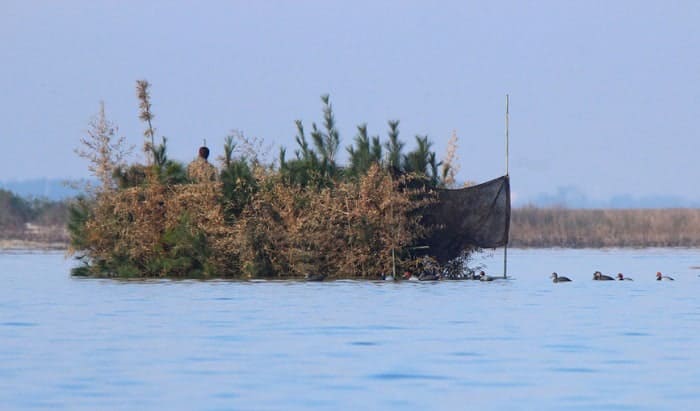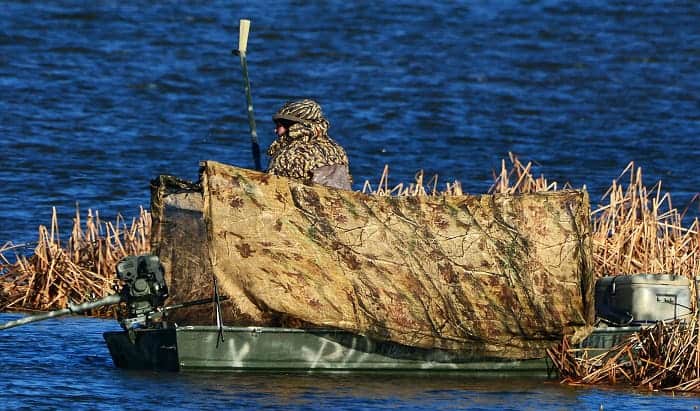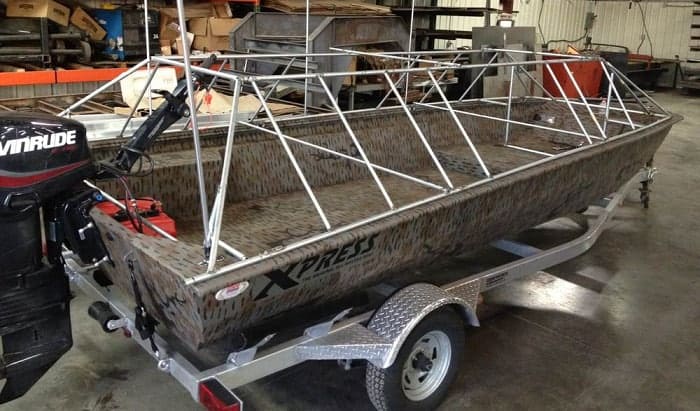
The presence of your hunting boat may be known to ducks and other fowls. Naturally, they will be aloof and fly away, making it difficult for you to catch them.
Since this situation is inevitable, it is important to learn how to build a duck blind for a boat.
A DIY duck boat blind can conceal your craft and ensure that animals cannot detect its presence. PVC frames, metal frames, and scissors are some of the things that you need to make it.
Aside from applying camouflage paint on your boat, you can customize a duck boat blind based on the type of hunting boat that you have. Different options are revealed in this article. So, read on!
Table of Contents
Important Factors Before Starting To Make A Duck Blind

1. Choose a Prime Location
It’s not the type of terrain that matters the most. You should choose a place where there’s an abundant supply of acorns, duct potatoes, widgeon grass, and other food that can attract waterfowls even in winter.
The ideal place should have low hunting pressure to guarantee that the fowls will stick around. An accessible wetland for covering up is one of the ideal locations for making a duck blind.
The sun’s position and the predominant wind direction are essential factors in choosing a location for a duck blind. You have to arrange these elements in your duck boat blind plan, and they’re supposed to be behind you.
You have to see to it that the waterfowls won’t be distracted by the light from your blind within the shooting range. Making a honey hole is also clever as it’s consistent in holding ducks every hunting season.
But you can still venture into another ideal location. You may need to do it if a certain habitat is no longer filled with prey. Ducks and fowls prefer to live in areas with an abundance of food.
A clear view is also important. So, you don’t have to put a lot of coverage that might obstruct your vision on the water and sky.
2. Design and Materials
The size of the blind depends on the members of the hunting party. A six-foot-wide and 16-foot long blind can accommodate four individuals. There’s even a space for one or two people.
You can get creative with the design but don’t forget about setting the blind up for comfort and productivity when hunting. A solid foundation will ensure that it won’t collapse any time.
Make the back wall higher than the front so that there is spacious headroom and hunters won’t have to squat. To allocate more space for vegetation as well as structural integrity, add dividers.
3. A Hiding Place
Clusters of cattails and willow trees are some of the many things that you can use to conceal your duck blind. You may also gather green vegetation to patch up the gap and let it blend with the surrounding.
Utilizing lush vegetation for covering up is conducive during spring and summer. You’ll only be compromised when leaves fall off.
Secure these things together with the help of some woven metal wire and twist ties. Use brown or olive drab paint to cover the interior and exterior. Rust-Oleum Camouflage Spray, TotalBoat Aluminum Boat Paint, and Hunter Specialties Spray Paints are suitable paints for your duck blind.
Brown netting is also helpful in concealment. The boxy form is not what you need to achieve. Instead, work on different spaces and heights to give it a natural look.
Various Methods on How to Build a Duck Blind for a Boat

Hunters are busy building the right duck blind for their boats when the duck season commences. You may just buy a rock solid duck boat blind kit. However, there are various DIY homemade duck boat blind frames. You’re free to pick the one that suits you well.
1. Beavertail Boat Blind
To start with the frame of the beavertail boat blind, you have to vertically mount four pieces of pipes overlapping the boat’s frame. Ubolts are the recommended hardware for attachment.
The vertical pipes should be curved for assembly. Make sure that the horizontal pipes are parallel to the boat’s length. Conduit pipes and T-connectors are essential in this regard.
The camo covering of this frame should be rectangular and draping down after being mounted on the curved pipes. It can be rolled up when not in use.
You’ll find features in this blind that don’t exist in other designs. The clearance from gunnel to gunnel is terrific. Thus, you can have access to storage, gun boxes, and bench seats without creating chaos inside the blind.
It’s considered a versatile design and you can have it on Jon boats with square front or semi V-front. It can be converted into a field blind in just 5 minutes by changing the blind legs to ground legs.
2. Pontoon Boat Blind
This design is customized for pontoons. You have to directly mount the frame to an existing railing that should be a bit bigger. A bunch of T connectors is needed for this project as well as some 45-degree pipe connectors as a support on the corners.
The T connectors and pipes are linked to complete square sections, which will tie up the brush that you’ll load on top.
3. Wide-Framed Boat Blind
This boat blind is mostly composed of several conduit bends. It will be great to add blend clips for enhanced support.
Most hunters like this design. Two pipes are placed on the entire length of the side rails. There should be connecting pipes on both sideways for the front and the back parts.
The goal in making this frame is to create a triangle shape. It is done by bending the pipes and adding 90-degree connectors in every corner and T connectors on the other parts. To complete the frame, you’ll need to have a couple of side-to-side connecting pipes.
Once the triangular frame is done, you can add coverings and other camo items. It’s also called an A-frame blind that’s perfect for waterway, marsh, grain field, and fence line.
4. Removable Frame
Since this is a removable frame, you have to assemble it first before doing any attachments. After bending the corners, they should be connected to the main rungs by shelf couplings. Run the pipes continuously with vertical pipes and T connectors.
To offset the second level, make a slight angle. It’s almost similar to the previous one but its width is narrower. Three arches are needed to branch off on the second level to complete the frame. When off-season comes, you can put this in safekeeping because it’s removable.
5. Ultimate and Elaborate Frame
If you’re up for making this elaborate frame, you should be ready for a lot of connections, bends, and techniques. Anyway, having a tubing bender can make the job easier.
With a lot of demands from this design, some hunters just pick out some ideas from it. Hence, it’s fine if you don’t fully copy it.
Just like with other frames, construction starts at the base. You’ll need connectors that are compatible with the EMT conduit. The base or rail should have a diameter of .92 mm for the connection.
You can make a railing on your own if it’s not available. Don’t worry as there are straightforward methods of attaching the boat’s base pipe layer.
The examples are two-hole straps together with some sort of metal self-tapping screws and a combination of nuts and bolts. Use U-bolts to warrant the much-needed security of all the connections.
6. Jon Boat Blind
This is a large Jon boat duck blind with a unique style as it splits into two sides. It’s not the common single frame that you usually see. You’ll make one side higher than the other, and would be able to cover both of them.
No conduit is connected on the outside frame, which is usually required by other designs. A type of flange is used in mounting this frame onto the boat’s various structural points.
A 90-degree connector is used on the pipes to form a sharp 90-degree edge. This additional part falls into the conduit bend that ends up on the boat’s edge.
The pipes should be in the right position to support any covering. T connectors and 45-degree connectors are needed to complete this step.
7. Scissor Duck Blind
You can use the boat’s pedestal base without needing to drill holes. Some may need to modify the base. Rig up the pipes to obtain the right angle in creating the scissor form. It’s the most important thing that you have to include in your duck boat scissor blind plan.
It’s easy to ensure visibility when making a duck blind. But what sets this scissor blind apart from other designs is its ability to stay firm against strong wind. It gives sturdiness to the roof that you make above it.
Conclusion
Learning how to build a duck blind for a boat is fun. You get to choose the design that works best for you. Be smart in selecting the one that can give way to concealment and visibility. Gathering the right materials is essential too.
Before starting your project, you have to pick the perfect location to ensure that you’ll always have a good hunting day.

“I am James Harvey – founder of Boating Basics Online. It is established with the drive to help out first-time boaters, which are those desiring to explore their way through the water. So if you are new to boating, start from here with me. “
